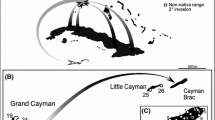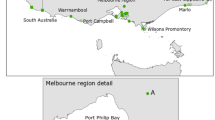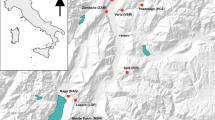Abstract
Invasive species are a major threat to global biodiversity. The US state of Florida is especially susceptible to the spread of exotic reptiles due to its subtropical climate, disturbed habitats, and robust pet trade. The Argentine black-and-white tegu (Salvator merianae) is a large, omnivorous lizard currently established in two different regions of Southern Florida. These two populations pose potential threats to sensitive ground nesting species such as gopher tortoises, American crocodiles, and migratory birds. At present, the introduction histories of these populations and the degree to which they are connected by gene flow are largely unknown. To address these issues, we genotyped S. merianae from Hillsborough and Miami-Dade Counties at ten microsatellite loci to assess intrapopulation genetic diversity, the degree of gene flow between populations, and compare the plausibilities of several potential introduction scenarios. Our results indicate that both populations have low genetic diversity [mean number of effective alleles across loci in both populations = 2.09 and are highly differentiated from each other (GST = 0.170; G″ST = 0.545)]. In addition, our results suggest that these populations underwent a bottleneck event prior to their divergence. We discuss what our results suggest about the histories of Florida’s invasive tegu populations, as well as how they inform ongoing management strategies.






Similar content being viewed by others
References
Abdelkrim J, Pascal M, Calmet C, Samadis S (2005) Importance of assessing population genetic structure before eradication of invasive species: examples from insular Norway rat populations. Conserv Biol 19(5):1509–1518
Abe AS (1983) Observation on dormancy in tegu lizards—Tupinambis teguixin (Reptilia, Teiidae). Naturalia 8:135–139
Bartlett RD, Bartlett P (1996) Monitors, tegus, and related lizards: everything about selection, care, nutrition, diseases, breeding, and behavior. Barron’s Educational Series, Inc, Hauppauge
Bhargava A, Fuentes FF (2010) Mutational dynamics of microsatellites. Mol Biotechnol 44:250–266
Bilgin R (2007) kgtests: a simple Excel Macro program to detect signatures of population expansion using microsatellites. Mol Ecol Notes 7:416–417
Braverman JM, Hudson RR, Kaplan NL, Langley CH, Stephan W (1995) The hitchhiking effect on the site frequency spectrum of DNA polymorphisms. Genet 140:783–796
Brito SP, Abe AS, Andrade DV (2001) Tupinambis merianae (tegu lizard). Longev Herpetol Rev 32:260–261
Cardozo G, Naretto S, Zak M, Chiaravigilio M (2012) The role of landscape in contact zones o sister species of lizards. In: Tiefenbacher J (ed) Perspectives on nature conservation—patterns, pressures and prospects. James and Marilyn Lovell Center for Environmental Geography and Hazards Research, Department of Geography Texas State University, San Marcos, pp 161–176
Chamut S, Jahn GA, Arce OEA, Manes ME (2012) Testosterone and reproductive activity in the male tegu lizard, Tupinambis merianae. Herpetol Conserv Biol 7(3):299–305
Chardonnet P, Des Clers B, Fisher J, Gerhold R, Jori F, Lamarque F (2002) The value of wildlife. Revue Scientifique et Technique de l’Office International des Epizooties 21:15–51
Clavero M, Garcı ́a-Berthou E (2005) Invasive species are a leading cause of animal extinction. Institute of Aquatic Ecology, Uiversity of Girona, Girona
Corander J, Marttinen P, Siren J, Tang J (2008) Enhanced Bayesian modelling in BAPS software for learning genetic structures of populations. BMC Bioinform 9:539
Corbett-Detig RB, Hartl DL, Sackton TB (2015) Natural selection constrains neutral diversity across a wide range of species. PLoS Biol 13:e1002112
Cornuet J-M, Pudlo P, Veyssier J, Dehne-Garcia A, Gautier M, Leblois R, Marin J-M, Estoup A (2014) DIYABC v2. 0: a software to make approximate Bayesian computation inferences about population history using single nucleotide polymorphism, DNA sequence and microsatellite data. Bioinform 30:1187–1189
Di Castri F (1989) Hisotry of biological invasions with special emphasis on the old world. In: Drake JA (ed) Biological invasions: a global perspective. John Wiley, New York
Di Rienzo A, Peterson AC, Garza JC, Valdes AM, Slatkin M, Freimer MB (1994) Mutational processes of simple-sequence repeat loci in human populations. Proc Natl Acad Sci USA 91(8):3166–3170
Do C, Waples RS, Peel D, Macbeth G, Tillett BJ, Ovenden JR (2014) NeEstimator v2: re-implementation of software for the estimation of contemporary effective population size (Ne) from genetic data. Mol Ecol Resour 14:209–214
Duarte Varela CF, Cabrera MR (2000) Testing skeletochronology in black tegu lizards (Tupinambis merianae) of known ages. Herpetol Rev 31:224–226
Dyer RJ (2012) The gstudio package. Virginia Commonwealth University, Virginia
Earl DA, vonHoldt BM (2012) STRUCTURE HARVESTER: a website and program for visualizing STRUCTURE output and implementing the Evanno method. Conserv Genet Resour 4(2):359–361
Embert D, Fitzgerald L, Waldez F (2010) Salvator merianae. IUCN 2013. IUCN red list of of threatened species. Version 2013.2
Enge KM (2007) FWC bioprofile for the Argentine black and white tegu (Tupinambis merianae). Florida Fish and Wildlife Conservation Commission Report, Tallahassee, 27 pp
Estoup A, Jarne P, Cornuet JM (2002) Homoplasy and mutation model at microsatellite loci and their consequences for population genetics analysis. Mol Ecol 11:1591–1604
Evanno G, Regnaut S, Goudet J (2005) Detecting the number of clusters of individuals using the software STRUCTURE: a simulation study. Mol Ecol 14:2611–2620
Excoffier L, Lischer HEL (2010) Arlequin suite ver 3.5: a new series of programs to perform population genetic analyses under Linux and Windows. Mol Ecol Resour 10:564–567
Falush D, Stephens M, Pritchard JK (2003) Inference of population structure using multilocus genotype data: linked loci and correlated allele frequencies. Genetics 164:1567–1587
Fitzgerald LA (1994) The interplay between life history and environmental stochasticity: implication for the management of exploited lizard populations. Am Zool 34:371–381
Fitzgerald LA, Cruz FB, Perotti MG (1993) The reproductive cycle and size at maturity of Tupinambis rufescens (Sauria: Teiidae) in the dry Chaco of Argentina. J Herpetol 27:70–78
Fu Y-X (1997) Statistical tests of neutrality of mutations against population growth, hitchhiking and background selection. Genetics 147:915–925
Fu Y-X, Li W-H (1993) Statistical tests of neutrality of mutations. Genetics 133:693–709
Galetti M, Bovendorp RS, Fadini RF, Gussoni COA, Rodrigues M, Alvarez AD, Guimaraes PR, Alves K (2009) Hyper-abundant mesopredators and bird extinction in an Atlantic forest island. Zoologia 26:288–298
Garza JC, Williamson EG (2001) Detection of reduction in population size using data from microsatellite loci. Mol Ecol 10:305–318
Guichoux E, Lagache L, Wagner S, Chaumeil P, Leger P, Lepais O, Lepoittevin C, Malausa T, Revardel E, Salin F, Petit RJ (2011) Current trends in microsatellite genotyping. Mol Ecol Resour 11:591–611
Hall BJ (1978) Notes on the husbandry, behaviour and breeding of captive tegu lizards. Int Zoo Yearb 18:91–95. https://doi.org/10.1111/j.1748-1090.1978.tb00229.x
Holm S (1979) A simple sequentially rejective multiple test procedure. Scand J Stat 6:65–70
Jakobsson M, Rosenberg NA (2007) CLUMPP: a cluster matching and permutation program for dealing with label switching and multimodality in analysis of population structure. Bioinform 23:1801–1806
Jombart T (2008) adegenet: a R package for the multivariate analysis of genetic markers. Bioinform 24(11):1403–1405
Jombart T, Collins C (2015) A tutorial for discriminant analysis of principal components (DAPC) using adegenet 2.0.0. Imperial College London, MRC Centre for Outbreak Analysis and Modelling, London
Jombart T, Sebastien D, Balloux F (2010) Discriminant analysis of principal components: a new method for the analysis of genetically structured populations. BMC Genet 11:94
Kaplan NL, Hudson R, Langley C (1989) The “hitchhiking effect” revisited. Genetics 123:887–899
Kiefer MC, Sazima I (2002) Diet of juvenile tegu lizard Tupinambis merianae (Teiidae) in southeastern Brazil. Amphib-Reptil 23:105–108
Klug PE, Reed RN, Mazzotti FJ, McEachern MA, Vinci JJ, Craven KK, Yackel Adams AA (2015) The influence of disturbed habitat on the spatial ecology of Argentine black and white tegu (Tupinambis merianae), a recent invader in the Everglades ecosystem (Florida, USA). Biol Invasion 17:1785–1797
Krysko KL, Burgess JP, Rochford MR, Gillete CR, Cueva D, Enge KM, Somma LA, Stabile JL, Smith DC, Wasilewski JA, Kieckhefer GN III, Granatosky MC, Nielson SV (2011) Verified non-indigenous amphbians and reptiles in Florida from 1983 through 2010: outlining the invasion process and identifying invasion pathways and stages. Zootax 3028:1–64
Lanfri S, Di Cola V, Naretto S, Chiaraviglio M, Cardozo G (2013) Understanding the ecological niche to elucidate spatial strategie of the southernmost Tupinambis lizards. Amphib Reptil 34:551–565
Luxmoore R, Groombridge B, Broads S (1988) Significant trade in wildlife: a review of selected species in CITES Appendix II. Volume 2: reptiles and invertebrates. IUCN Conservation Monitoring Centre, Cambridge, 306 pp
Mack RN, Simberloff D, Lonsdale WM, Evans H, Clout M, Bazzaz FA (2000) Biotic invasions: causes, epidemiology, global consequences, and control. Ecol Appl 10:689–710
Maynard-Smith J, Haigh J (1974) The hitch-hiking effect of a favourable gene. Gene Res 23:23–35
Mazzotti FJ, McEachern M, Rochford M, Reed RN, Eckles K, Vinci J, Edwards J, Wasilewski J, J (2015) Tupinambis merianae as nest predators of crocodilians and turtles in Florida, USA. Biol Invas 17:47–50
Meirmans P, Hedrick PW (2011) Assessing population structure: FST and related measures. Mol Ecol Resour 11:5–18
Mercolli C, Yanosky A (1994) The diet of adult Tupinambis teguixin (Sauria: Teiidae) in the eastern chaco of Argentina. Herpetol J 4:15–19
Mieres MM, Fitzgerald LA (2006) Monitoring and managing the harvest of tegu lizards in Paraguay. J Wildl Manag 70:1723–1734
Mooney HA, Cleland EE (2001) The evolutionary impact of invasive species. PNAS 98(10):5446–5451
Nei M, Chesser RK (1983) Estimation of fixation indices and gene diversities. Ann Hum Genet 47:253–259
Paetkau D, Calvert W, Stirling I, Strobeck C (1995) Microsatellite analysis of population structure in Canadian polar bears. Mol Ecol 4:347–354
Paetkau D, Slade R, Burden M, Estoup A (2004) Genetic assignment methods for the direct, real-time estimation of migration rate: a simulation-based exploration of accuracy and power. Mol Ecol 13:55–65
Peakall R, Smouse PE (2012) GenAlEx 6.5: genetic analysis in Excel. Population genetic software for teaching and research—an update. Bioinform 28:2537–2539
Peery MZ, Kirby R, Reid BN, Stoelting R, Doucet-Bëer E, Robinson S, Vásquez-Carrillo C, Pauli JN, Palsbøll PJ (2012) Reliability of genetic bottleneck tests for detecting recent population declines. Mol Ecol 14:3403–3418
Pernas T, Giardina DJ, McKinley A, Parns A, Mazzotti FJ (2012) First observations of nesting by the Argentine black and white tegu, Tupinambis merianae, in South Florida. Southeast Nat 11(4):765–770
Pew J, Muir PH, Wang J, Frasier TR (2015) Related: a R package for analyzing pairwise relatedness from codominant molecular markers. Mol Ecol Res 15:557–561
Piry S, Luikart G, Cornuet J-M (1999) BOTTLENECK: a program for detecting recent effective population size reductions from allele data frequencies. Montpellier, France
Piry S, Alapetite A, Cornuet JM, Paetkau D, Baudouin L, Estoup A (2004) GENECLASS2: a software for genetic assignment and first-generation migrant detection. J Hered 95:536–539
Pritchard JK, Stephens M, Donnelly P (2000) Inference of population structure using multilocus genotype data. Genet 155:945–959
Queller DC, Goodnight KF (1989) Estimating relatedness using molecular markers. Evol 43:258–275
R Core Team (2014) R: a language and environment for statistical computing. R Foundation for Statistical Computing
Ramasamy RK, Ramasamy S, Bindroo BB, Naik VG (2014) STUCTURE PLOT: a program for drawing elegant STRUCTURE bar plots in user friendly interface. Springer 3:431
Reich DE, Goldstein DB (1998) Genetic evidence for a Paleolithic human population expansion in Africa. Proc Natl Acad Sci 95:8119–8123
Reich DE, Feldman MW, Goldstein DB (1999) Statistical properties of two tests that use multilocus data sets to detect population expansion. Mol Biol Evol 16(4):453–466
Rollins LA, Woolnough AP, Wilton AN, Sinclair RON, Sherwin WB (2009) Invasive species can’t cover their tracks: using microsatellites to assist management of starling (Sturnus vulgaris) populations in Western Australia. Mol Ecol 18:1560–1573
Rousset F (2008) GENEPOP 007: a complete re-implementation of the GENEPOP software for Windows and Linux. Mol Ecol Resour 8:103–106
Schrider DR, Shanku AG, Kern AD (2016) Effects of linked selective sweeps on demographic inference and model selection. Genetics 116:190223
Sella G, Petrov DA, Przeworski M, Andolfatto P (2009) Pervasive natural selection in the Drosophila genome? PLoS Genet 5:e1000495
Smith KG (2006) Patterns of nonindigenous herpetofaunal richness and biotic homogenization among Florida counties. Biol Conserv 127:327–335
Stephan W, Wiehe TH, Lenz MW (1992) The effect of strongly selected substitutions on neutral polymorphism: analytical results based on diffusion theory. Theor Pop Biol 41:237–254
Tajima F (1989a) The effect of change in population size on DNA polymorphism. Genet 123:597–601
Tajima F (1989b) Statistical method for testing the neutral mutation hypothesis by DNA polymorphism. Genet 123:585–595
Van Oosterhout C, Hutchinson WF, Wills DPM, Shipley P (2004) MICRO-CHECKER: software for identifying and correcting genotyping errors in microsatellite data. Mol Ecol Notes 4:535–538
Wake DB, Vredenburg VT (2008) Are we in the midst of the sixth mass extinction? A view from the world of amphibians. PNAS. https://doi.org/10.1073/pnas.0801921105
Waples RS, Do C (2008) LDNE: a program for estimating effective population size from data on linkage disequilibrium. Mol Ecol Resour 8:753–756
Waples RS, Do C (2010) Linkage disequilibrium estimates of contemporary Ne using highly variable genetic markers: a largely untapped resource for applied conservation and evolution. Evol Appl 3:244–262
Weir BS, Cockerham CC (1984) Estimating F-statistics for the analysis of population structure. Evol 38:1358–1370
Wilcove DS, Rothstein D, Dubow J, Phillips A, Losos E (1998) Assessing the relative importance of habitat destruction, alien species, pollution, over-exploitation, and disease. BioSci 48:607–616
Wilson GA, Rannala B (2003) Bayesian inference of recent migration rates using multilocus genotypes. Genet 163:1117–1119
Winck GR, Cechin SZ (2008) Hibernation and emergence pattern of Tupinambis merianae (Squamata: Teiidae) in the Taim Ecological Station, southern Brazil. J Nat Hist 42:239–247
Wood JW, Campbell TS, Page RB (2015) Characterization of 14 novel microsatellite loci in the Argentine black and white tegu (Salvator merianae) via 454 pyrosequencing. Amphib Reptil 36:444–449
Wood JW, Dowell SA, Campbell TS, Page RB (2016) Insights into the introduction history and population genetic dynamics of the Nile monitor (Varanus niloticus) in Florida. J Hered. https://doi.org/10.1093/jhered/esw014
Zayed A, Whitfield CW (2008) A genome-wide signature of positive selection in ancient and recent invasive expansions of the honey bee Apis mellifera. Proc Natl Acad Sci USA 105:3421–3426
Acknowledgements
JPW and RBP would like to thank their late friend and mentor, David H. Reed, for his advice and support during the earliest phases of this project. We also gratefully acknowledge Jennifer Ketterlin Eckles, Colin Hughes, Tessie Offner, Kenneth L. Krysko, Kevin Enge, Balm Boyette Scrub Preserve, USDA-APHIS, and the South Florida Water Management Group for providing samples, field resources and assistance, lodging, logistics, and site access.
Author information
Authors and Affiliations
Corresponding authors
Ethics declarations
Conflict of interest
Jared Wood was directly supported by the Columbus Zoo and Aquarium and by the Wallace Endowment to the University of Louisville, Department of Biology. Stephanie Dowell Beer declares that she has no conflict of interest. Todd Campbell received funding for field work from the Charlotte Harbor National Estuary Program, the National Fish and Wildlife Foundation, the Institute for Biological Invasions at the University of Tennessee, and the University of Tampa Dana grant. Robert Page declares that he has no conflict of interest.
Electronic supplementary material
Below is the link to the electronic supplementary material.
10709_2018_40_MOESM1_ESM.pdf
ESM1_PCA_IndividualPops. Principal component analysis based on raw genotypes of introduced S. merianae populations in Florida, showing Miami-Dade and Hillsborough populations separately. Numbers correspond to individual identification numbers. Individuals 37 and 42 were excluded from the analysis (PDF 44 KB)
10709_2018_40_MOESM2_ESM.pdf
ESM2_kmeans_BIC. Plot depicting the Bayesian information criterion (BIC) as a function of K-means clustering solutions for different values of K (Number of clusters) (PDF 119 KB)
10709_2018_40_MOESM3_ESM.pdf
ESM3_DAPC_Structure_like_plot. Bar plot depicting DAPC cluster membership probabilities. The color scheme is the same as Fig. 4. Letters under each bar indicate the region in which each individual was sampled (H = Hillsborough County, M = Miami-Dade County) (PDF 478 KB)
10709_2018_40_MOESM4_ESM.pdf
ESM4_meanLnProb_Hillsborough. Mean Ln P(D) ± SD for 10 replicate STRUCTURE runs at each value of K using only the Hillsborough data as input (PDF 12 KB)
10709_2018_40_MOESM5_ESM.pdf
ESM5_meanLnProb_MiamiDade. Mean Ln P(D) ± SD for 10 replicate STRUCTURE runs at each value of K using only the Miami-Dade data as input (PDF 13 KB)
10709_2018_40_MOESM6_ESM.docx
ESM6_Introduction scenarios_table. Confidence in scenario selection by DIYABC for the introduction pathway of S. merianae into Florida. Posterior probabilities are based on the logistic approach, implemented by the program, and the type I and type II error rates were calculated based on 100 simulated pseudo-observed data sets (pods) (DOCX 14 KB)
10709_2018_40_MOESM7_ESM.pdf
ESM7_Posterior Probabilities. Plot showing the posterior probability results from the approximate Bayesian computation for seven competing introduction scenarios for S. merianae in Florida (PDF 3 KB)
Rights and permissions
About this article
Cite this article
Wood, J.P., Beer, S.D., Campbell, T.S. et al. Insights into the introduction history and population genetic dynamics of the Argentine black-and-white tegu (Salvator merianae) in Florida. Genetica 146, 443–459 (2018). https://doi.org/10.1007/s10709-018-0040-0
Received:
Accepted:
Published:
Issue Date:
DOI: https://doi.org/10.1007/s10709-018-0040-0




